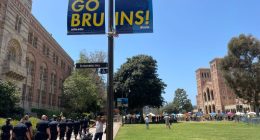[This story contains spoilers for The Batman.]
Gotham. From whose eyes are we watching it? No, this isn’t a riddle. But it is the first question The Batman invites audiences to ask as we watch a family from behind binocular lenses. The sound of ragged breathing creates its own tempo, working in tandem with the vocalization of “Ave Maria.” These elements suggest an act of prayerful voyeurism. But what is being prayed for? The will to commit to the pre-meditated act, or the asking of forgiveness for the act already committed to?
From the onset, the Riddler (Paul Dano) is aligned with our perception of Bruce Wayne (Robert Pattinson), and Bruce Wayne aligned with Selina Kyle (Zoë Kravitz), perpetual orphaned children caught between feeling invisible and wanting to be seen, yet at the mercy of something bigger than any of them can fully fathom. Perhaps The Batman is doing more than retracing the ideas of good, evil and the morally gray through its three central costumed characters, but rather is looking at Batman, Catwoman and the Riddler as three disciples of Gotham, each one suggesting an answer to the riddle of what Gotham is, and what it has the potential to become.
God or Gotham. Reeves grapples with no higher powers than these within The Batman, as he seeks to redefine these characters and fit them into our modern-day Americana, one in which cops are infrequently heroes, political change does not occur without revolution, and the fairy-tale narrative attached to perpetual children and wealthy orphans no longer carries the weight it once did.
Reeves is not the first filmmaker to tackle Batman’s world with a keen sense of social awareness, but his vision of Gotham feels the most like a character, a forge in which people are made, rather than born. Every action taken in this city, perhaps even guided by this city, sets off a larger reaction or consequence. The central characters in the film are not only struggling to change through their personal journeys, but struggling to change in a city that has given them definition and purpose.
Batman, the Riddler and Catwoman exist because of, and in service to, a city with unknowable designs, and thus must project their own images — a bat, a cat, a question mark — onto it, giving Gotham a totemistic power. This near-supernatural approach to Gotham is something tackled in the comics, a number of which inspired Reeves. Writers like Peter Milligan and Grant Morrison explored this notion through their respective stories, Dark Knight, Dark City (2011) and Batman R.I.P. (2008). Writer Scott Snyder also painted Gotham as a sentient city, one that had literally affected the chemistry of Batman and his rogues through pools of the substance Dionesium existing below Gotham’s surface. All three writers built their Batman sagas, and Gotham’s history and effect on its citizens, around Barbatos, a demonic elder god who is the scar running through Gotham.
Reeves takes a more grounded route in exposing the evils of Gotham’s history in The Batman. There’s no demon to blame, only men. The bedrock from which Batman, Catwoman and the Riddler are formed hasn’t been chemically altered by some magical substance that has allowed them to evolve in modern myths. Rather, they are formed by the failures of the institutions and social structures meant to hold them together but which instead leave all three painfully split in their identities. The scars of Gotham in The Batman set the stage for both political division and a keen allegory for our contemporary American political ideologies.
Though creator Frank Miller popularized the idea of an extremist, some would argue fascist, Batman in The Dark Knight Returns, Reeves’ Batman is politically disengaged, or naïve at best. At least at first. He questions whether Batman works because he’s essentially a bandage over Gotham’s gaping wounds. Beating up punks in a subway station may save a life, but it doesn’t affect the systemic issues that plague Gotham and give rise to these symptoms.
Batman needs to be a surgeon. This metaphor may invoke Batman’s famous line from The Dark Knight Returns, “It’s an operating table, and I’m the surgeon,” but Reeves’ Gotham requires a subtler read on that line. The Batman shouldn’t exist to cut further wounds into Gotham, but to stitch it back together, to reckon with the many ways in which the flesh of the city is torn and sew it up. It’s a challenge that, as mayoral candidate Bella Real (Jayme Lawson) suggests, will also rely on Bruce Wayne returning to the public and creating change beyond just charitable donations.
In order to heal Gotham, he must inherit his father’s legacy. Bruce Wayne cannot simply exist as a figure of wealth but must be a healer as well, like his surgeon father. But Thomas Wayne’s decision to heal the wounded Falcone (John Turturro) decades prior ultimately led to the city’s downfall. Bruce, as Batman — and as both a Wayne and an Arkham — is faced with the choice of which wounds to mend, and to have faith that the consequences will ultimately reconstruct Gotham for the better.
The Riddler, despite his love for puzzles, cannot reconstruct Gotham as it is. Instead, he attempts to destroy it, scattering the pieces and submerging them in water so that they can no longer fit. His is the position of a political extremist. While his winter combat mask, lack of a personal life outside of his social media fan base, and proclivity toward violence certainly bear some resemblance to incel culture and the underground white supremacy movement that has infected the minds of too many young white men, Riddler’s ideology isn’t right-wing.
His desire to root out corruption, to force politicians and cops to face accountability, and to interrogate the rich about where their money goes, all reflect certain, noble, efforts of the left. But the Riddler’s means of accomplishing these things aren’t noble, and his extremism and persona feel like Gotham’s own manifestation of horseshoe theory, in which the far-left and far-right aren’t so different in their lust for blood and war through the sacrifice of lives for some subjective “greater good.” As much as the Riddler is bringing his form of “justice” to the guilty, his final act of flooding Gotham also punishes the innocent and poor.
With The Batman being released amid the war between Russian and Ukraine, Riddler’s sentiment of washing away the sins of Gotham with Old Testament efficiency aren’t a far cry from the American ultra-left social media accounts who initially praised the possibility of war between the U.S. and Russia, suggesting that an attack at home be the means to rid America of its corruption, the cruelty of the Republicans, the ineffectiveness of the Democrats and any future leaders that would place themselves within that same two-party cycle. This, of course, ignores, the fact that it’s traditionally been the poor and minority populations who suffer the greatest consequences of war, while the power of the rich only grows.
The Riddler’s final efforts create a power vacuum, one that only allows for the possibility of salvation or further corruption. It’s a gamble, rather than a solution. As smart as the Riddler is, he can’t see past his own desire for vengeance, and that is what ultimately separates him and Batman. The Riddler would kill Gotham, would kill his god, for a chance to validate his existence and see his beliefs confirmed. While Batman has the ability to shift perspective, to see Gotham in a new way, and have faith that with time and effort, a solution will become clear.
While Batman searches for answers about the death of his parents, the Riddler and Selina have already found the answers they were searching for before the start of the film. Riddler knows that Gotham’s corruption landed him in the poorly maintained orphanage of his youth. Selina knows that Carmine Falcone is her father and has abandoned her to a life of being forced to scrap for herself. Unlike the Riddler and Batman, Selina isn’t seeking to change Gotham, only change the circumstances for herself and those she cares about. Gotham abandoned her, and women like her, and as a result she has no need to see what Gotham will become once she takes what she needs from it. The journey of these three characters, all linked by abandonment, is an effort to find validation in blood sacrifice, Riddler through the death of Gotham’s corrupt city officials, Selina through the death of her father, and Batman, through the sacrifice of his own life.
The Riddler is the manifestation of Gotham’s horror, yes, but also, its thirst for vengeance. Catwoman is Gotham’s shadow, a surviving piece that will never quite align with what others want Gotham to become. And Batman? He begins the film thinking that he is horror and vengeance, until he learns about the Riddler. Then he becomes Gotham’s hope, and potential for systemic change. Again, these characters are disciples of Gotham, and none of them is wrong in terms of representing what the city is.
Reeves leaves judgment up to the audience. Whose brand of vigilantism was most effective? The Riddler, for rooting out corruption and then attempting to wash Gotham clean to begin again? Catwoman, for removing the wealth and power of rich, white men, so that she can save the only scraps of Gotham that matter to her? Or Batman, for realizing that to save Gotham he has to be a symbol of hope, rather than fear for those he wishes to protect? “I believe in Gotham City,” the line which opens Jeph Loeb and Tim Sale’s The Long Halloween, a central inspiration for The Batman, is echoed within the film, both through dialogue and theme. It’s more than a political slogan and a pledge against corruption, it is a prayer signifying belief in Gotham’s people and the power they have to transform it.
The Batman’s trio of costumed vigilantes, and the way in which they’ve reshaped Gotham at the end of the film, is the personification of that power. Gotham is left open to a power grab, a new sitting mayor, Bella Real, and the need for a new D.A. and police chief, as the city stands on the verge of collapse. With the Riddler locked away with an inmate (Barry Keoghan) who truly sees him, Selina free from her ties to Gotham, and Batman on a new path, whose prayers for Gotham have been answered? Which Gotham are we left to believe in?
Source: Hollywood









